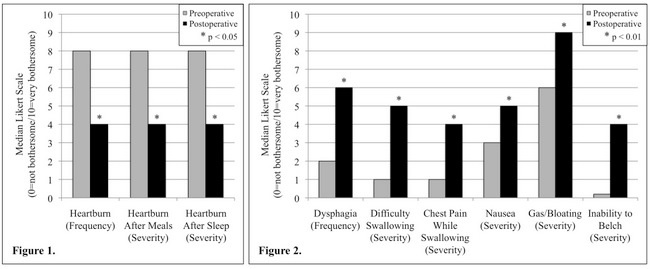Leigh A Humphries, Kenneth Luberice, BS, Sharona B Ross, MD, Alexander S Rosemurgy, MD. Digestive Disorders Center, Tampa General Hospital, Tampa, FL, USA
Introduction: Laparoscopic fundoplication is the “gold standard” therapy for GERD, though success after laparoscopic fundoplication is not uniform. This study was undertaken to determine the causes of dissatisfaction following laparoscopic fundoplication.
Methods: 1063 patients undergoing laparoscopic fundoplication scored the frequency and severity of symptoms before and after fundoplication, and graded their experiences from Very Satisfying to Very Dissatisfying. Objective outcomes were determined by endoscopy, barium swallow study, and pH monitoring. Additional data were obtained from clinic notes and written patient comments. Median data are reported.
Results: 101 (9.5%) patients, 58% female and age 55 years, reported dissatisfaction following laparoscopic fundoplication (95 Nissen, 4 Toupet, 2 Dor); 22 (22%) operations were “redo” fundoplications. 2 (2%) operations were converted from laparoscopic to “open”. 10 (10%) patients experienced notable complications (pneumonia 2, pulmonary edema 2, bowel obstruction 1, enterotomy 1, gastric leak 1, intraperitoneal bleeding 1, prolonged ileus 1, dysphagia 1). Length of stay was 1 day. Follow-up was 33 months. After fundoplication, heartburn significantly decreased in frequency and severity (p < 0.05, Wilcoxon matched pairs test), but remained notable (Figure 1). Postoperatively, new symptoms, including dysphagia, nausea, and aerophagia-related symptoms, were prevalent and severe (p < 0.01) (Figure 2). New symptoms were the most prominent postoperative complaint for 59% of patients, followed by symptoms of reflux recurrence (23%) or persistence (4%). 14% of patients had other primary complaints including postoperative complications, hospital personnel, and hospital bills. Failed fundoplication occurred in 5 (5%) patients, and two of these patients subsequently underwent “redo” fundoplications.

Conclusions: Dissatisfaction is uncommon after laparoscopic fundoplication. Postoperative complications and “redo” fundoplications are “risk factors” for dissatisfaction. Although heartburn symptoms improved following fundoplication, they persisted or recurred for many dissatisfied patients. New symptoms, mainly dysphagia and gas/bloating, are the primary causes of dissatisfaction. Other factors involving healthcare delivery also greatly influence the patient experience and satisfaction. Overall, fundoplication effectively palliates most, but not all, symptoms of GERD. Future efforts should focus on avoiding new troublesome symptoms after laparoscopic fundoplication and on improving the total patient experience.
Session: PDIST
Program Number: P012
View Poster